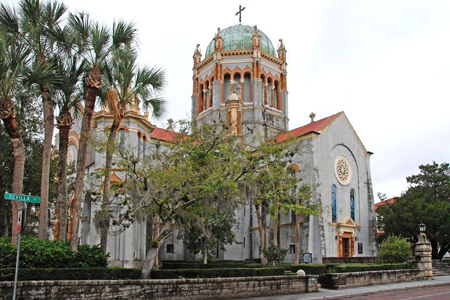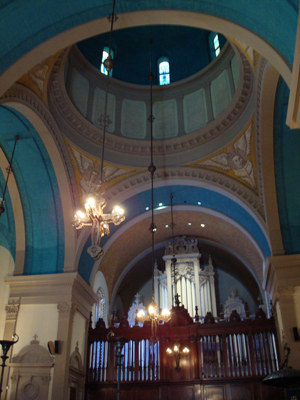| |
 |
 |
 |
| Comment on this report, or find other reports. |
 |
| Our Mystery Worshippers are volunteers who warm church pews for us around the world. If you'd like to become a Mystery Worshipper, start here. |
 |
| Find out how to reproduce this report in your church magazine or website. |
|
|
| 1641: Memorial
Presbyterian, St Augustine,
Florida, USA |
 |
 |
 |
Mystery Worshipper:
Preacher's Kid.
The church:
Memorial
Presbyterian (also known as Flagler Memorial), St Augustine,
Florida, USA.
Denomination:
Presbyterian Church
(USA).
The building:
If the Presbyterians ever have a cathedral, this will be it!
The congregation was organized in 1824 and the present building
dates from 1890, a gift from the oil and railroad magnate Henry
M. Flagler. It was designed by the New York firm of Carrere
and Hastings, who also designed the Arlington Cemetery Amphitheater
and Tomb of the Unknowns, the Frick Collection, the New York
Public Library, and Goldwin Smith Hall and Rockefeller Hall
at Cornell University, among dozens of other equally famous
structures. The architectural style is Venetian Renaissance
– most popular for grand buildings in Florida at the time. This
style is evident in the huge copper dome rising about 150 feet
overhead and the ornate terra cotta frieze done by Italian artists.
The woodwork is all hand-carved Santo Domingo mahogany. Although
cruciform, the floor plan strikes you as a bit odd upon entering:
what traditionally would be the nave is in fact the transepts.
In the north end is a chapel with chairs that can be reversed
to provide overflow seating and large sliding doors to close
the chapel off for smaller services. What traditionally would
be thought of as the north transept is in fact the area which,
from back to front, contains the organ case and choir seating
behind a screen at a second-story level, and a congregational-style
rostrum for the clergy. There is a lectern centrally located
from which the readings are done, and to the right, or gospel
side, is a pulpit with a sea-shell reflector. Below the lectern
on the floor is the baptismal font which in communion services
converts to the Lord's Table. The chandeliers are three-dimensional
crosses and may well have been gaslights at installation. Four
torches also illuminate the crossing. The Flagler family tomb
is connected to the transept.
The church:
Their numerous ministries and outreaches are well described
on their website. Among these are a Presbyterian day school,
a women's circle, Sunday school and fellowship groups for young
people, and a prayer chain. During the week there are choir
rehearsals, committee meetings including those of the trustees
and deacons, and seniors activities. The church provides rehearsal
area of the St Augustine Children’s Choir. They have two
services on Sunday morning, with the earlier service at 8.30
being an abbreviated version of the later service, according
to the leaflet.
The neighborhood:
St Augustine (which the locals pronounce AWE-gus-teen) was founded
by Spanish explorers in 1565 and is the oldest continuously
occupied European-founded community in the continental United
States. Plundered by pirates and burned by the British, it came
under British rule, along with all of Florida, after the French
and Indian War (1754–1763), known in England as the Seven
Years' War. After the American Revolution, Florida was ceded
back to Spain and remained under Spanish rule until 1821, when
it was acquired by the United States. In the 19th century, when
Henry Flagler's railroads came to town, St Augustine became
a winter resort for the very wealthy. A number of mansions and
palatial grand hotels of this era still exist, as do several
Spanish colonial structures. The city remains a popular tourist
destination. The church is in a neighborhood that dates from
the 19th century. The truly old and historic part of town is
only a short distance away. The neighborhood houses are medium
to very expensive in appearance.
The cast:
The Revd Dr J. Dudley Weaver, Jr, chief pastor, opened the service,
read the gospel, preached the sermon and officiated at communion.
Mary M. McKemy, director of Christian education, led the prayer
of confession and declaration of pardon. Adam Smith, director
of youth and college ministries, read the Old Testament lesson
and led the prayer of illumination, affirmation of faith and
the prayer after communion. Also assisting in various roles
were Susan Abare, Dorothy Dornblaser and Karen Harvey. Ray McDonald,
organist and director of music, presided at the organ and led
the choir.
The date & time:
All Saints Sunday, November 2, 2008, 11.00am.
What was the name of the service?
Holy Communion.
How full was the building?
About 75 percent. The make-up of the congregation seemed to
be a cross section of people of varying means. There were quite
a number of tourists and seasonal residents (popularly known
as "snowbirds") escaping colder winter climes.
Did anyone welcome you
personally?
Two ladies and a gentlemen were at the door when we approached and they greeted us warmly, provided us with service leaflets and escorted us to a seat. The people sitting next to us smiled warmly and welcomed us.
Was your pew comfortable?
Comfortable unpadded pews facing inward from both directions
in the nave (remember, they are really long transepts). The
pews could very well be the originals – they are built in the
English style on very short platforms and fit into the mosaic
tile patterns of the floor.
How would you describe the pre-service
atmosphere?
The organ voluntaries were lush (see more later) and people
were quietly exchanging greetings with one another.
What were the exact opening words of the
service?
"The grace of our Lord Jesus Christ be will you all."
What books did the congregation
use during the service?
The Presbyterian Hymnal and The Holy Bible, New
Revised Version. There was also a service leaflet containing
almost everything needed except for one or two hymns. The service
leaflet was in fact almost an exact copy of Rite II from the
Book of Common Prayer of the Episcopal Church.
What musical instruments
were played?
Organ and piano. The organ is one of the last great American-styled
instruments built by the Aeolian-Skinner Company in 1970. In
1995, Knowlton Pipe Organs of Davidson, North Carolina, modernized
the organ console with computerized technology, and in 2000
the console was again rebuilt and restored by Roger Colby, Inc.
of Johnson City, Tennessee. Hymns sung during the service, and
sung enthusiastically, were those traditional to All Saints
Day. The congregation sang the Sanctus as well as the Agnus
Dei. Three different adaptations of the hymn tune Lasst
Uns Erfreuen were done: the initial voluntary by the noted
contemporary organist and composer Rick Deasley, the hymn itself
("Ye watchers and ye holy ones"), and the closing
voluntary by the 20th century Swiss composer Rufolf Moser. The
organist's voluntaries throughout the service included pieces
that would be instantly familiar to anyone reared in the American
Deep South. One of his opening pieces was variations on the
old gospel song "When the roll is called up yonder,"
which is no longer included in any Protestant hymnal I know.
At communion he improvised on "Shall we gather at the river."
The excellent choir sang Gerard Francis Cobb's Hark! The
Sound of Holy Voices at the introit; Lloyd Larson's Holy
Ground at the offertory; and David Angerman's A Song
of Parting at the close of the service.

Did anything distract
you?
The congregation seemed a bit talkative at the beginning of
the service and at points during the service when action was
down. A small boy kept going into and departing from the choir
loft for no apparent reason.
Was the worship stiff-upper-lip, happy clappy, or
what?
If ever there was a high-church Presbyterian church, particularly
in the American South, this is it! The service could easily
have been mistaken for an Episcopalian eucharist. Departures
from the Prayer Book included the placement of the peace in
the order of the service, the use of the Apostles' Creed rather
than the Nicene Creed, and the inclusion of a declaration of
pardon rather than an absolution. The church welcomed about
a dozen new members, using a modification of the confirmation
rite from the Prayer Book. The Lord's Prayer was the "debts/debtors"
version. At communion, members of the Session distributed hosts
to everyone in the congregation, who then consumed them all
together. The wine was administered in the same manner. Incense
and bells were neither expected nor present, although a chime
was tolled as the names of deceased congregants were read.
Exactly how long was the sermon?
20 minutes.
On a scale of 1-10, how good was the preacher?
9 – The Revd Dr Dudley is truly a senior minister and has
the grand style of a Southern gentleman and scholar. He preached
from the pulpit, which, interestingly, is closer to the floor
than the lectern.
In a nutshell, what was
the sermon about?
Dr Dudley's theme was "Know who you are, and whose you are."
He emphasized that we are part of what has gone before and certainly
part of what will come after. Our parents and our family, both
filial and spiritual, make us what we are, and in turn we carry
the influence forward.
Which part of the service
was like being in heaven?
This church is an almost total sensory experience – the
only thing lacking for me was incense. The beauty of the place,
the spirit of the congregation, the announced continuing gratitude
to the benefactor, the spirituality of the leaders and their
message made for a wonderful Christian experience.
And which part was like being in... er... the other place?
The "children's moment": Only one child went to the
front. The subject was dull, and I couldn't see the person conducting
the matter. It would seem to me that children's church could
be done a bit better and differently – and in another
place!
What happened when you hung around after the service looking lost?
We walked around the church and viewed the Flagler crypt, the
chapel, and the parlors adjacent to the chapel. We were invited
for coffee in the garden but by the time we got there it had
run out. The church started a tradition three or four years
ago of a pilgrimage to the nearby Huguenot cemetery for a blessing
of those buried there, and everyone was quite involved in getting
that assembled and done.
How would you describe the after-service
coffee?
No coffee for us, unfortunately!
How would you feel about making this church your regular (where 10 = ecstatic, 0 = terminal)?
9 – If I lived in the area this would certainly be a candidate
for me, although I am of another denomination. The worship experience
was first rate.
Did the service make you
feel glad to be a Christian?
Absolutely! The worship experience was every bit as awesome
as the sensory experience of the place. This church and its
congregation outdid expectations. I commend it to anyone visiting
the area, or moving there.
What one thing will you
remember about all this in seven days' time?
The children's moment, but more importantly, the music and the
sermon. |
|
|
 |
 |
 |
| We rely on voluntary donations to stay online. If you're a regular visitor to Ship of Fools, please consider supporting us. |
 |
 |
 |
| The Mystery Pilgrim |
 |
| One of our most seasoned reporters makes the Camino pilgrimage to Santiago de Compostela in Spain. Read here. |
 |
 |
 |
| London churches |
 |
| Read reports from 70 London churches, visited by a small army of Mystery Worshippers on one single Sunday. Read here. |
| |
|
|
|
|


